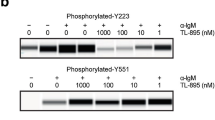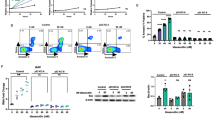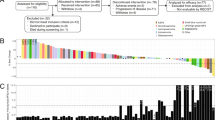Abstract
STI571 is a selective tyrosine kinase inhibitor with proven therapeutic potential in malignancies expressing c-kit. A strong c-kit and stem cell factor expression was detected in the Hodgkin and Reed Sternberg cell line L1236, but not in 20 primary cases of classical Hodgkin's disease. Proliferation of L1236 cells was neither affected by addition of stem cell factor nor by neutralising anti-stem cell factor antibodies or STI571. Results suggest that patients with Hodgkin's disease may not benefit from therapy with STI571.
Similar content being viewed by others
Main
The malignant cells in classical Hodgkin's disease (cHD), the Hodgkin and Reed Sternberg cells (H-RS), are mostly derived from germinal centre B-cells as indicated by somatic mutations within their rearranged immunoglobulin genes (Küppers and Rajewsky, 1998). Nevertheless, H-RS cells phenotypically exert several characteristics not typical for B-cells. They lack expression of most B-cell specific proteins (Drexler, 1992) and, instead, express proteins restricted to other lineages or to immature precursor cells (Cossman et al, 1998). Expression of c-kit as a marker of an immature phenotype, for instance, has been described in H-RS cells in cHD previously (Pinto et al, 1994).
The tyrosine kinase inhibitor STI571 has been shown to selectively inhibit the receptor tyrosine kinases v-abl and bcr–abl, the platelet derived growth factor receptor (PDGFR) and the receptor for the stem cell factor, i.e. c-kit (Druker et al, 1996; Buchdunger et al, 2000; Heinrich et al, 2000). This specific activity of STI571 is already exploited for tumour control in chronic myelogeneous leukaemia (Druker et al, 2001) and soft tissue sarcomas (Joensuu et al, 2001). It recently has been proposed (Buchdunger et al, 2000) that STI571 may also be effective in other malignancies expressing receptors for PDGF or c-kit. We here evaluate the expression of c-kit in HD derived cell lines and cases of cHD in order to test the therapeutic potential of STI571 for cHD.
Materials and methods
Cell lines and pathological specimen
The characteristics of the six HD derived cell lines are summarised by Drexler (1993) and Wolf et al (1996). L1309 is an EBV immortalised lymphoblastoid cell line from a healthy donor. M07e is a myeloid leukaemia cell line purchased at DSMZ (Braunschweig, Germany). Twenty primary cases of classical HD (seven mixed cellularity, nine nodular sclerosis, two lymphocyte depleted, two lymphocyte rich classical) and a case of gastrointestinal mesenchymal stromal tumour were analysed by immunohistochemistry. Immunohistochemistry was performed on paraffin embedded formalin-fixed specimen according to standard protocols using a polyclonal rabbit anti-human c-kit antibody (DAKO, Hamburg, Germany).
Flow cytometry
Hodgkin's disease derived cell lines were incubated with a phycoerythrin conjugated mouse anti-human CD117 monoclonal antibody (clone 95C3; AnDerGrub, Austria) following the instructions of the manufacturer and analysed on a Becton-Dickinson FACS Calibur.
Proliferation assay
Hodgkin's disease derived cell lines and LCL1309 were plated in 96-well flat bottom culture plates at a density of 20 000 cells per well. M07e cells were plated at 50 000 cells per well and cultured in the presence of stem cell factor (SCF) (200 ng ml−1; R&D, Germany). Recombinant human SCF, neutralising anti-human SCF antibody (dissolved in phosphate buffered saline; R&D) or STI571 (dissolved in DMSO; provided by Dr Elizabeth Buchdunger, Novartis Pharma, Basel, Switzerland) was added according to the respective experimental setup. At 48 h MTT was added to each well and cells were lysed after 2 h following the instructions of the manufacturer (TACS assay; R&D).
Polymerase chain reaction and sequence analysis
High molecular weight DNA was extracted from L1236 cells according to standard protocols. Amplification and sequencing of exon 11 and 17 was performed at 55°C as described previously (Re et al, 2001) using published oligonucleotides (Tian et al, 1999).
Human SCF immunoassay
Amounts of SCF were quantified in 24 h supernatants from cell lines using a commercially available ELISA kit (Quantakine; R&D).
Results and discussion
Analysis of c-kit and SCF expression in HD derived cell lines
Using FACS analysis, a strong cell surface expression of c-kit was detected in the HD derived cell line L1236 while c-kit expression was absent in five other HD derived cell lines (L428, KM-H2, L591, Hdlm-2, L540) (Table 1). Secretion of the c-kit ligand SCF was tested in the supernatant of all six HD derived cell lines and controls. Low amounts of SCF were detected in L1236 and M07e cell cultures (53 and 30 pg ml−1, respectively). Detection of both SCF and c-kit in L1236 cells suggested an autocrine mechanism of growth control in L1236 cells.
Treatment of HD-derived cell lines with SCF, anti-SCF antibodies and STI571
In order to further characterise the postulated autocrine role of the c-kit/SCF interaction for proliferation and viability of L1236 cells, a MTT (dimethylthiazol–diphenyltetrazolium bromide) based assay was performed with L1236 cells and controls (M07e was used for positive control and cell lines L428 and LCL1309 for negative control). As shown in Figure 1A, addition of SCF to cell cultures stimulated growth of control cells M07e but not of L1236 cells. Accordingly, after addition of a neutralising anti-SCF antibody to the cell cultures, proliferation of M07e but not of L1236 cells was inhibited (Figure 1B).
Proliferation of c-kit positive L1236 cells is not influenced upon stimulation with SCF, anti-SCF antibodies or the c-kit inhibitor STI571. Forty-eight-hours MTT proliferation assay with the HD derived cell lines L1236 (c-kit+/SCF+) and L428 (c-kit−/SCF−), the lymphoblastoid cell line 1309 (c-kit−/SCF−) as negative control and the myeloid cell line M07e (c-kit+/SCF+) as postivie control. Incubation of cell lines with increasing doses of (A) stem cell factor (SCF); (B) neutralising anti-SCF antibody; (C) tyrosine kinase inhibitor STI571. Each experiment was performed in triplicate and repeated at least three times. Mean value of proliferation and single standard deviation of representative experiments are shown.
Mutant constitutively active c-kit receptors that are found e.g. in mast cell disease (Longley et al, 1996) may cause an SCF independent proliferation of c-kit expressing cells. Since these activating c-kit mutations mostly have been detected in exon 11 and exon 17, we performed L1236 DNA sequence analysis of c-kit exon 11 and 17 (GenBank accession number 1817732: base pair 75662–75788 and 81257–81463). These experiments revealed germ line configuration of both exons (data not shown). It is thus concluded, that SCF independence of L1236 proliferation is unlikely to be due to DNA mutations of the c-kit gene.
When cells were treated with the tyrosine kinase inhibitor STI571, positive controls but not H-RS cells showed a marked decrease of c-kit dependent proliferation at STI571 doses of 0.1 to 1 μmol l−1 (Figure 1C). With increasing doses of STI571, L1236 cells as well as negative controls L428 and LCL1309 showed reduction of proliferation rate possibly due to unspecific toxic effects.
Immunostaining of H-RS cells in situ for c-kit expression
Twenty primary cases of cHD were immunostained using a monoclonal antibody specific for c-kit. A gastrointestinal mesenchymal stromal tumour with known strong cell surface expression of c-kit (Hirota et al, 1998) was used as positive control. Absence of c-kit expression was found in H-RS cells of all twenty cases. This negative result was somewhat surprising as Pinto et al (1994) reported a partially strong c-kit expression in most H-RS cells of 11 out of 17 cases of cHD. The c-kit receptor protein expression was selectively detected in cases of cHD and anaplastic large cell lymphoma while it was absent in cases of non-Hodgkin's lymphoma. It therefore has been speculated, that c-kit may be activated in an autocrine or paracrine fashion and regulate growth of c-kit expressing neoplastic cells. In contrast, our results suggest, that H-RS cells commonly do not express c-kit. These immunohistochemical analyses are well conceivable with our in vitro experiments suggesting, that activation of c-kit is not even involved in control of proliferation of c-kit positive H-RS cells of the cell line L1236. It is therefore concluded, that administration of the c-kit inhibitor STI571 may not be beneficial for patients with cHD.
Accession codes
Change history
16 November 2011
This paper was modified 12 months after initial publication to switch to Creative Commons licence terms, as noted at publication
References
Buchdunger E, Cioffi CL, Law N, Stover D, Ohno-Jones S, Druker BJ, Lydon NB (2000) Abl protein-tyrosine kinase inhibitor STI571 inhibits in vitro signal transduction mediated by c-kit and platelet-derived growth factor receptors. J Pharmacol Exp Ther 295: 139–145
Cossman J, Messineo C, Bagg A (1998) Reed-Sternberg cell: survival in a hostile sea. Lab Invest 78: 229–235
Drexler HG (1992) Recent results on the biology of Hodgkin and Reed-Sternberg cells. I. Biopsy material. Leuk Lymphoma 8: 283–313
Drexler HG (1993) Recent results on the biology of Hodgkin and Reed-Sternberg cells. II. Continuous cell lines. Leuk Lymphoma 9: 1–25
Druker BJ, Talpaz M, Resta DJ, Peng B, Buchdunger E, Ford JM, Lydon NB, Kantarjian H, Capdeville R, Ohno-Jones S, Sawyers CL (2001) Efficacy and safety of a specific inhibitor of the BCR-ABL tyrosine kinase in chronic myeloid leukemia. N Engl J Med 344: 1031–1037
Druker BJ, Tamura S, Buchdunger E, Ohno S, Segal GM, Fanning S, Zimmermann J, Lydon NB (1996) Effects of a selective inhibitor of the Abl tyrosine kinase on the growth of Bcr-Abl positive cells. Nat Med 2: 561–566
Heinrich MC, Griffith DJ, Druker BJ, Wait CL, Ott KA, Zigler AJ (2000) Inhibition of c-kit receptor tyrosine kinase activity by STI571, a selective tyrosine kinase inhibitor. Blood 96: 925–932
Hirota S, Isozaki K, Moriyama Y, Hashimoto K, Nishida T, Ishiguro S, Kawano K, Hanada M, Kurata A, Takeda M, Muhammad Tunio G, Matsuzawa Y, Kanakura Y, Shinomura Y, Kitamura Y (1998) Gain-of-function mutations of c-kit in human gastrointestinal stromal tumors. Science 279: 577–580
Joensuu H, Roberts PJ, Sarlomo-Rikala M, Andersson LC, Tervahartiala P, Tuveson D, Silberman S, Capdeville R, Dimitrijevic S, Druker B, Demetri GD (2001) Effect of the tyrosine kinase inhibitor STI571 in a patient with a metastatic gastrointestinal stromal tumor. N Engl J Med 344: 1052–1056
Küppers R, Rajewsky K (1998) The origin of Hodgkin and Reed/Sternberg cells in Hodgkin's disease. Annu Rev Immunol 16: 471–493
Longley BJ, Tyrrell L, Lu SZ, Ma YS, Langley K, Ding TG, Duffy T, Jacobs P, Tang LH, Modlin I (1996) Somatic c-KIT activating mutation in urticaria pigmentosa and aggressive mastocytosis: establishment of clonality in a human mast cell neoplasm. Nat Genet 12: 312–314
Pinto A, Gloghini A, Gattei V, Aldinucci D, Zagonel V, Carbone A (1994) Expression of the c-kit receptor in human lymphomas is restricted to Hodgkin's disease and CD30+ anaplastic large cell lymphomas. Blood 83: 785–792
Re D, Müschen M, Ahmadi T, Wickenhauser C, Holtick U, Startschek-Jox A, Diehl V, Wolf J (2001) Oct-2 and Bob-1 deficiency in Hodgkin and Reed Sternberg cells. Cancer Res 61: 2080–2084
Tian Q, Frierson Jr HF, Krystal GW, Moskaluk CA (1999) Activating c-kit gene mutations in human germ cell tumors. Am J Pathol 154: 1643–1647
Wolf J, Kapp U, Bohlen H, Kornacker M, Schoch C, Stahl B, Mücke S, von Kalle C, Fonatsch C, Schaefer HE, Hansmann ML, Diehl V (1996) Peripheral blood mononuclear cells of a patient with advanced Hodgkin's lymphoma gives rise to permanently growing Hodgkin-Reed Sternberg cells. Blood 87: 3418–3428
Acknowledgements
We thank Julia Jesdinsky and Nadia Massoudi for technical assistance and Novartis (Basel, Switzerland) for kindly providing STI571. Supported by the Deutsche Forschungsgemeinschaft through Sonderforschungsbereich 502. D Re is supported by the Friedrich und Maria Sophie Moritz'sche Stiftung.
Author information
Authors and Affiliations
Corresponding author
Rights and permissions
From twelve months after its original publication, this work is licensed under the Creative Commons Attribution-NonCommercial-Share Alike 3.0 Unported License. To view a copy of this license, visit http://creativecommons.org/licenses/by-nc-sa/3.0/
About this article
Cite this article
Re, D., Wickenhauser, C., Ahmadi, T. et al. Preclinical evaluation of the antiproliferative potential of STI571 in Hodgkin's disease. Br J Cancer 86, 1333–1335 (2002). https://doi.org/10.1038/sj.bjc.6600243
Received:
Revised:
Accepted:
Published:
Issue Date:
DOI: https://doi.org/10.1038/sj.bjc.6600243
Keywords
This article is cited by
-
Impact of imatinib on the pharmacokinetics and in vivo efficacy of etoposide and/or ifosfamide
BMC Pharmacology (2007)
-
Lack of c-kit (CD117) expression in CD30+ lymphomas and lymphomatoid papulosis
Modern Pathology (2004)




